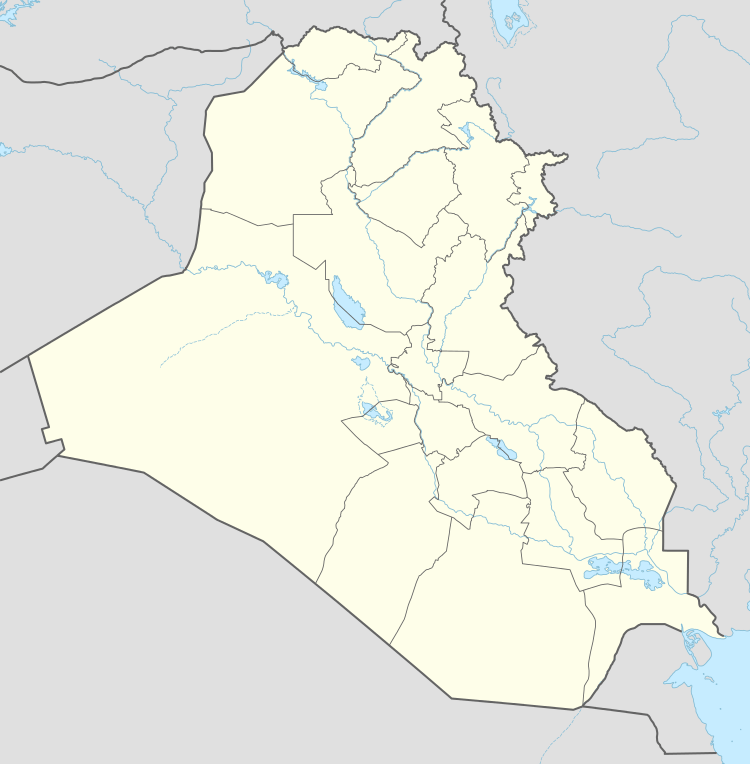Hassuna culture
The Hassuna culture is a Neolithic archaeological culture in northern Mesopotamia dating to the early sixth millennium BC. It is named after the type site of Tell Hassuna in Iraq. Other sites where Hassuna material has been found include Tell Shemshara.
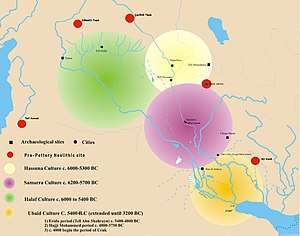 | |
| Geographical range | Mesopotamia |
|---|---|
| Period | Neolithic |
| Dates | circa 6000 BC |
| Type site | Tell Hassuna |
| Major sites | Tell Shemshara |
| Preceded by | Pre-Pottery Neolithic B, Yarmukian culture, Halaf culture |
| Followed by | Ubaid period |
Description
By around 6000 BC people had moved into the foothills (piedmont) of northernmost Mesopotamia where there was enough rainfall to allow for "dry" agriculture in some places. These were the first farmers in northernmost Mesopotamia. They made Hassuna-style pottery (cream slip with reddish paint in linear designs). Hassuna people lived in small villages or hamlets ranging from 2 to 8 acres (3.2 ha).
At Tell Hassuna, adobe dwellings built around open central courts with fine painted pottery replace earlier levels with crude pottery. Hand axes, sickles, grinding stones, bins, baking ovens and numerous bones of domesticated animals reflect settled agricultural life. Female figurines have been related to worship and jar burials within which food was placed related to belief in afterlife. The relationship of Hassuna pottery to that of Jericho suggests that village culture was becoming widespread.[1]
Proto-Hassuna
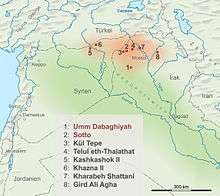
The site of Umm Dabaghiyah (de:Umm Dabaghiyah-Sotto-Kultur), in the same area of Iraq, is believed to have the earliest pottery in this region, and is sometimes described as a 'Proto-Hassuna culture' site. Other related sites in the area are Sotto, and Kul Tepe (Iraq).
Another pre-Hassuna or proto-Hassuna site in Iraq is Tell Maghzaliyah.
More recently, the concept of a very early 'Pre-Proto-Hassuna' pottery tradition has been introduced by some scholars. This has been prompted by more recent discoveries of still earlier pottery traditions.
Pre-Proto-Hassuna
Pre-Proto-Hassuna refers to the Late Neolithic period in Upper Mesopotamia when the ceramic containers were just being introduced, and the pottery vessels were still very few in number in these early settlements. At that time, the main emphasis was on the pottery with a mineral temper, as opposed to the plant-tempered pottery which came to predominate later.
The time frame for this initial Late Neolithic ceramic period was about 7000-6700 BC, and at this time stone vessels and White Ware were still being used in addition to pottery.[2] Because of the narrow local emphasis in many pottery studies as of now, these earliest pottery traditions may be known in literature as,
- Pre-Proto-Hassuna (in Khabur, and northern Iraq)
- Initial Pottery Neolithic (in Balikh River area, for example Tell Sabi Abyad)[3]
- Transitional (in Turkish Euphrates area; main sites are Mezraa Teleilat and Akarcay Tepe, with pottery dated to c. 6800 BC)
- Halula I (in Syrian Euphrates area; the main site is Tell Halula)
- Rouj 2a (in Northern Levant); several archaeological sites are located in the Rouj basin, Idlib, Syria).[4]
Nevertheless, all of these nomenclatures may refer to quite similar types of pottery, depending on some specific geographic region of Upper Mesopotamia.[2]
Artifacts
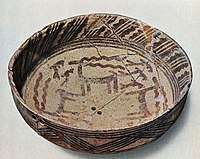 Hassuna redware bowl, circa 5500 BC
Hassuna redware bowl, circa 5500 BC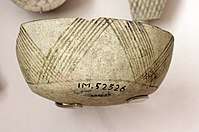 Fragment of pottery with incised and painted decor. From Tell Hassuna, 6500 - 6000 BC.
Fragment of pottery with incised and painted decor. From Tell Hassuna, 6500 - 6000 BC. Fragment of pottery with incised and painted decor. From Tell Hassuna, 6500 - 6000 BC.
Fragment of pottery with incised and painted decor. From Tell Hassuna, 6500 - 6000 BC.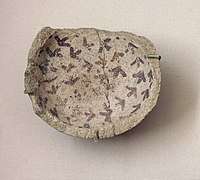 Fragment of pottery with incised and painted decor. From Tell Hassuna, 6500 - 6000 BC.
Fragment of pottery with incised and painted decor. From Tell Hassuna, 6500 - 6000 BC..jpg) Reconstitution of Neolithic dwelling in northern Mesopotamia (Akarcay Tepe II)
Reconstitution of Neolithic dwelling in northern Mesopotamia (Akarcay Tepe II)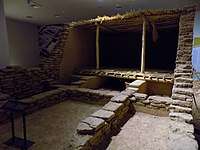 Reconstitution of Neolithic dwelling in northern Mesopotamia (Akarcay Tepe II)
Reconstitution of Neolithic dwelling in northern Mesopotamia (Akarcay Tepe II)
Chronology
References
- "The oldest pottery Neolithic of Upper Mesopotamia : New evidence from Tell Seker al-Aheimar, the Khabur, northeast Syria - Persée". Persee.fr. Retrieved January 18, 2017.
- Reinhard Bernbeck and Olivier Nieuwenhuyse (2013), ESTABLISHED PARADIGMS, CURRENT DISPUTES AND EMERGING THEMES: THE STATE OF RESEARCH ON THE LATE NEOLITHIC IN UPPER MESOPOTAMIA Publications on Archaeology of the Leiden Museum of Archaeology (PALMA), Brepols pub. (Turnhout, Belgium), 17-37
- The very oldest pottery of Tell Sabi Abyad (and of Syria), 7000-6700 BC http://www.sabi-abyad.nl
- Syro-Japanese Archaeological Investigation - Rouj Basin Project, Syria
- Liverani, Mario (2013). The Ancient Near East: History, Society and Economy. Routledge. p. 13, Table 1.1 "Chronology of the Ancient Near East". ISBN 9781134750917.
- Shukurov, Anvar; Sarson, Graeme R.; Gangal, Kavita (7 May 2014). "The Near-Eastern Roots of the Neolithic in South Asia". PLOS ONE. 9 (5): e95714. Bibcode:2014PLoSO...995714G. doi:10.1371/journal.pone.0095714. ISSN 1932-6203. PMC 4012948. PMID 24806472.
- Bar-Yosef, Ofer; Arpin, Trina; Pan, Yan; Cohen, David; Goldberg, Paul; Zhang, Chi; Wu, Xiaohong (29 June 2012). "Early Pottery at 20,000 Years Ago in Xianrendong Cave, China". Science. 336 (6089): 1696–1700. Bibcode:2012Sci...336.1696W. doi:10.1126/science.1218643. ISSN 0036-8075. PMID 22745428.
- Thorpe, I. J. (2003). The Origins of Agriculture in Europe. Routledge. p. 14. ISBN 9781134620104.
- Price, T. Douglas (2000). Europe's First Farmers. Cambridge University Press. p. 3. ISBN 9780521665728.
- Jr, William H. Stiebing; Helft, Susan N. (2017). Ancient Near Eastern History and Culture. Routledge. p. 25. ISBN 9781134880836.
